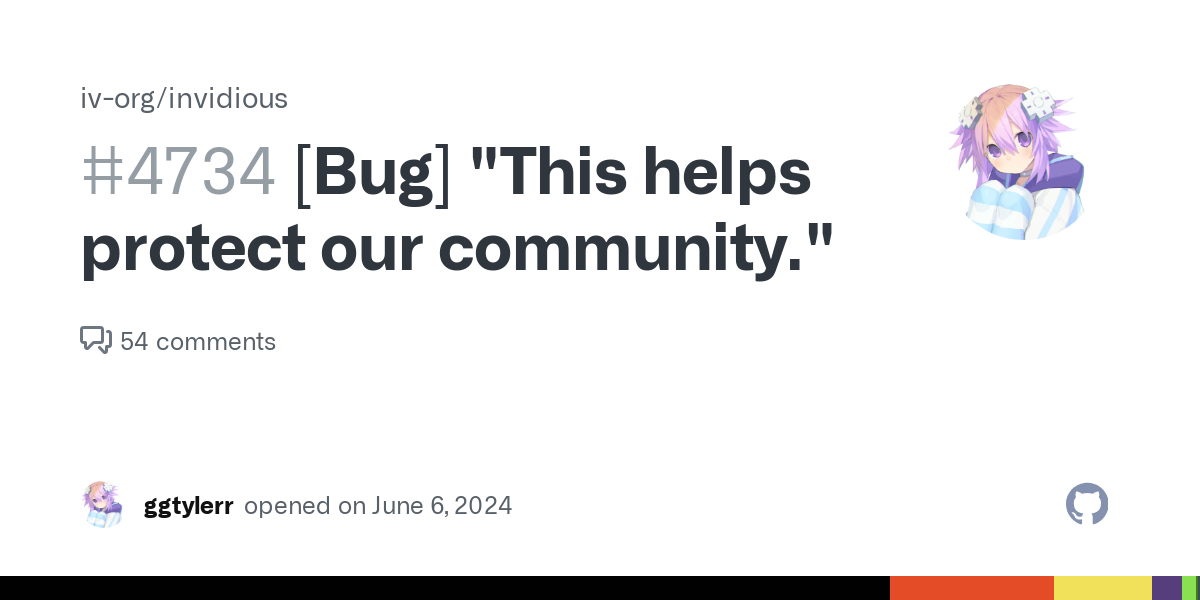cross-posted from: https://discuss.tchncs.de/post/22423685
EDIT: For those who are too lazy to click the link, this is what it says
Hello,
Sad news for everyone. YouTube/Google has patched the latest workaround that we had in order to restore the video playback functionality.
Right now we have no other solutions/fixes. You may be able to get Invidious working on residential IP addresses (like at home) but on datacenter IP addresses Invidious won’t work anymore.
If you are interested to install Invidious at home, we remind you that we have a guide for that here: https://docs.invidious.io/installation/..
This is not the death of this project. We will still try to find new solutions, but this might take time, months probably.
I have updated the public instance list in order to reflect on the working public instances: https://instances.invidious.io. Please don’t abuse them since the number is really low.



“Stupidly simple” might be overselling it when it comes to the masses adopting it. Not everyone is adept at “throwing together a script.”
That being said, I’m all for helping the masses adapt.
“Give me a Python script using yt-dlp that I can run on a cronjob that will download the videos from any of my subscribed channels since the last time the script was run”
You can use the following Python script to download videos from your subscribed channels since the last run. This script uses
yt-dlpand stores the last download timestamp to track new videos.First, ensure you have
yt-dlpinstalled:Then, create a script called
download_videos.py:import os import json import subprocess from datetime import datetime # Configuration last_run_file = 'last_run.json' download_directory = 'downloads' # Ensure the download directory exists os.makedirs(download_directory, exist_ok=True) # Load the last run time if os.path.exists(last_run_file): with open(last_run_file, 'r') as f: last_run = json.load(f)['last_run'] else: last_run = datetime.now().isoformat() # Update the last run time to now current_run = datetime.now().isoformat() # Command to get videos from subscribed channels since the last run command = [ 'yt-dlp', '--download-archive', 'archive.txt', '--output', f'{download_directory}/%(title)s.%(ext)s', '--date-after', last_run, '--no-post-overwrites', '--merge-output-format', 'mp4', 'https://www.youtube.com/channel/CHANNEL_ID', # Replace with your channel URL ] # Run the command subprocess.run(command) # Save the current run time with open(last_run_file, 'w') as f: json.dump({'last_run': current_run}, f) print("Download complete. Next run will check for videos since:", current_run)Setting Up the Cron Job
Make the script executable:
chmod +x download_videos.pyOpen your crontab:
Add a line to run the script at your desired interval (e.g., daily at 2 AM):
Notes
CHANNEL_IDin the script with your actual channel IDs or use a playlist URL if preferred.archive.txtfile keeps track of already downloaded videos to avoid duplicates.Another example, which i can personally verify has been working fine for months. It works a bit different to the above, it downloads the latests 2* vids that are not already downloaded and runs once every hour with cron. I also attempted to filter out live vids and shorts.
Channels i am “subscribed” too are stored in a single text file, it also uses the avc1 codec because i found p9 and p10 had issues with the jellyfin client on my tv.
looks like this, i added categories but i don’t actually use them in the script besides putting them in a variable, lol. Vid-limit is how many of the latests vids it should look at to download. The original reason i implemented that is so i could selectively download a bulk of latests vids if i wanted to.
Cat=Science Name=Vertitasium VidLimit=2 URL=https://www.youtube.com/channel/UCHnyfMqiRRG1u-2MsSQLbXA Cat=Minecraft Name=EthosLab VidLimit=2 URL=https://www.youtube.com/channel/UCFKDEp9si4RmHFWJW1vYsMA#!/bin/bash # Define the directory to store channel lists and scripts script_dir="/.../YTDL" # Define the base directory to store downloaded videos base_download_dir="/.../youtubevids" # Change to the script directory cd "$script_dir" # Parse the Channels.txt file and process each channel awk -F'=' ' /^Cat/ {Cat=$2} /^Name/ {Name=$2} /^VidLimit/ {VidLimit=$2} /^URL/ {URL=$2; print Cat, Name, VidLimit, URL} ' "$script_dir/Channels.txt" | while read -r Cat Name VidLimit URL; do # Define the download directory for this channel download_dir="$base_download_dir" # Define the download archive file for this channel archive_file="$script_dir/DLarchive$Name.txt" # Create the download directory if it does not exist mkdir -p "$download_dir" # If VidLimit is "ALL", set playlist_end option to empty, otherwise set it to --playlist-end playlist_end_option="" if [[ $VidLimit != "ALL" ]]; then playlist_end_option="--playlist-end $VidLimit" fi yt-dlp \ --download-archive "$archive_file" \ $playlist_end_option \ --write-description \ --write-thumbnail \ --convert-thumbnails jpg \ --add-metadata \ --embed-thumbnail \ --match-filter "!is_live & !was_live & original_url!*=/shorts/" \ --merge-output-format mp4 \ --format "bestvideo[vcodec^=avc1]+bestaudio[ext=m4a]/best[ext=mp4]/best" \ --output "$download_dir/${Name} - %(title)s.%(ext)s" \ "$URL" doneYeah this is more elegant and closer to what I’d actually want to implement. I was more just showing what could be done in literally thirty seconds on the can with ChatGPT.
I knew i recognized that output.
Mine is actually also made with the help of Chatgpt but manually refined and tested.